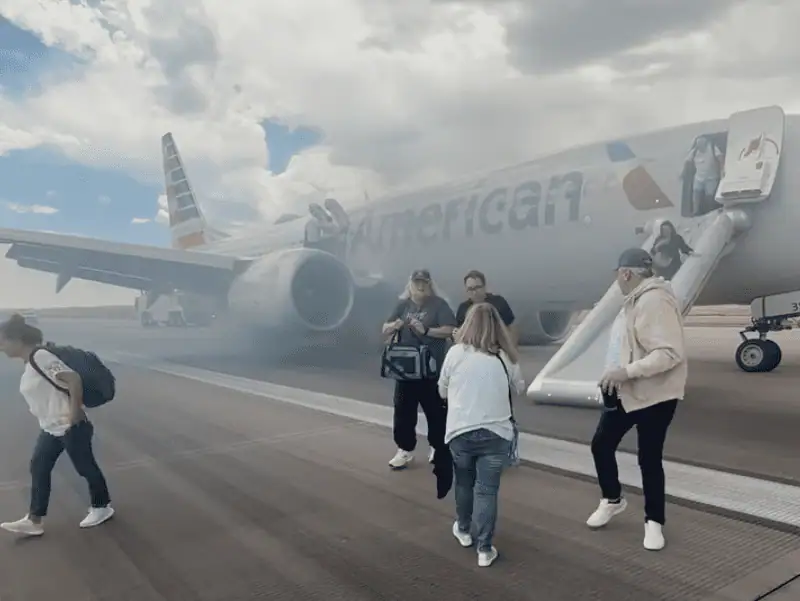
It’s 2025, and it seems like there’s an airline incident every other week! I remember earlier this year about American Airlines flight number 1006 that diverted to Denver due to high vibrations in the right engine that ultimately led to an engine fire and emergency evacuation. The pictures were interesting because you could see passengers standing on the left wing waiting to be rescued as there was smoke and fire on the other side of the aircraft. A few of the passengers had their luggage with them on the wing!
Denver and American Airlines were recently back in the news again due to another incident, and I wanted to talk about what I noticed, the implications therein, and what I learned since I was curious about regulations and such.
What happened with the American Airlines flight in Denver?
On Saturday July 26, 2025, an American Airlines B737 MAX 8 flight aborted take off after reports of lots of smoke. According to the Federal Aviation Administration (FAA), the flight reported “a possible landing gear incident” during departure.

Flight AA3023 was departing from Denver headed to Miami when the incident occurred around 2:45PM local time. Here’s first-hand video of the evacuation (<<< click/tap this if embedded video below doesn’t work):
From this first-hand video, you can clearly see the left-hand landing gear on fire with smoke. As the fire truck extinguishes it, more smoke emanates from the scene as passengers continue to evacuate.
The situation seems relatively calm even as passengers are hurriedly trying to evacuate the airplane. But with the smoke and the fire, it looked kinda dramatic!
According to the local CBS news outlet, all passengers and crew members evacuated safely. Thank goodness!
When I watched the video for the first time, what was immediately obvious to me was seeing most passengers were carrying their luggage with them. Due to being overencumbered as such, you can see some people slide down the evacuation slide badly and/or walk away clumsily.

You know how airline safety cards and safety briefings say to leave your luggage and bags behind in an emergency situation?
Yeah. Because…you’re supposed to evacuate quickly and not be an obstacle to yourself and others trying to evacuate as well.
But is that written or codified anywhere? I wondered about this and did a bit of research on what the FAA says about emergency evacuations.
What does the FAA say about emergency evacuations and luggage?
In my brief research, I didn’t find anything specific in the FAA regulations related to luggage in an emergency evacuation situation that sounded anything like “Thou shall not evacuate the aircraft with your luggage in an emergency situation.”

Rather, there are regulations that govern the design and operation of the aircraft and standards that need to be complied with. Allow me to describe them below:
Part 25.803 and Appendix J
Part 25 of Title 14 of the Code of Federal Regulations (CFRs) has to do with the airworthiness standards of transport category aircraft. The regulations in Part 25 have to do with the design of the aircraft.
In particular, section 803 is about emergency evacuations. Basically, the design of the interiors has to be such that everyone on board has the emergency means to allow rapid evacuation of the aircraft in a crash. And it has to be shown that the max seating capacity of the aircraft can be evacuated within 90 seconds
So how do you test the design of an aircraft for compliance to 25.803? That’s what Appendix J outlines. There are many requirements for how this test and demonstration must be carried out in order to show compliance.
Basically, the test environment and demonstration should simulate an emergency situation with typical representative passengers who cannot be pre-briefed on what to do or where to go.
Part 121.291 and Appendix D
Part 121 of the CFRs has to do with the operating requirements of air carriers.
And section 291 is for the demonstration of evacuation procedures. The important thing to note here is that the airline has to demonstrate that its evacuation procedures meet FAA requirements as outlined in this section. This regulation primarily deals with the criteria for having to do a demonstration like changing emergency exits or number of flight attendants.
Appendix D provides the criteria and additional guidance for meeting 121.291’s requirements.
Advisory Circular 25.803-1A
The FAA further provided additional guidance on the means at which to comply to 25.803 with Advisory Circular 25.803-1A in context of 121.291. Advisory Circulars are not mandatory to be implemented, but provide clarification and guidance on existing regulations and requirements.
Again, nothing in these regulations talk about passengers being restricted from taking their luggage during an emergency evacuation.
Should passengers grab their things during an emergency evacuation?

Done. End of story.
Jokes aside, I think there are two ways of looking at this: legally and practically.
From a legal perspective (Note: I am not an expert–the following are my opinions), there isn’t really anything that I’ve found that says it is criminal to evacuate an aircraft with your luggage. However, the FAA can impose civil penalties, the airline can as well, and maybe some cities/governments out there could also. So hey, if it’s not illegal and if the aircraft is not actively burning on the inside, then I can see how a passenger would rationalize grabbing one’s stuff before evacuating.
On the other hand, from a practical perspective…well, it isn’t practical to grab your stuff in an emergency evacuation.
The FAA regulations governing the design and operation of transport aircraft operated by airlines are there for a reason. No commercial transport aircraft would be flying unless the aircraft meets these requirements. Therefore, we know it has been previously shown that it IS possible to evacuate a full aircraft in 90 seconds or less.
Anything that would cause you or other passengers to be delayed in evacuating the aircraft safely should be avoided. Taking the time to grab your stuff out of the bin or from under the seat 1) takes time and 2) potentially creates another obstacle between you or other passengers and the emergency exit. And besides, luggage and other belongings could possibly damage the emergency slides and render them unusable, which wouldn’t be great in an emergency situation either especially to your fellow passengers.
But I can understand why passengers grab their stuff in these situations. Maybe there’s important, expensive things like electronics, work, medicines, etc. Maybe they don’t want to deal with the chaos of getting their bag returned later from the airline.
In my opinion, stuff can be replaced–life cannot. I’d rather live to see another day than die because I needed to rescue my cheap luggage I got from Walmart.
Bottom Line
AA3023 aborted takeoff at Denver’s airport due to a landing gear incident resulting in fire and smoke. Video of the evacuation showed passengers leaving the aircraft with their luggage.
FAA regulations govern the design and operation of transport aircraft, but don’t really make it unlawful for passengers to grab their belongings in emergency evacuations. Despite the lack of legal binding, passengers should still follow crew instructions and leave belongings behind as a practical means of evacuating rapidly and safely.
What do you think? Were the passengers who grabbed their stuff in the wrong?
Featured photo from @highlymigratoryfishing

